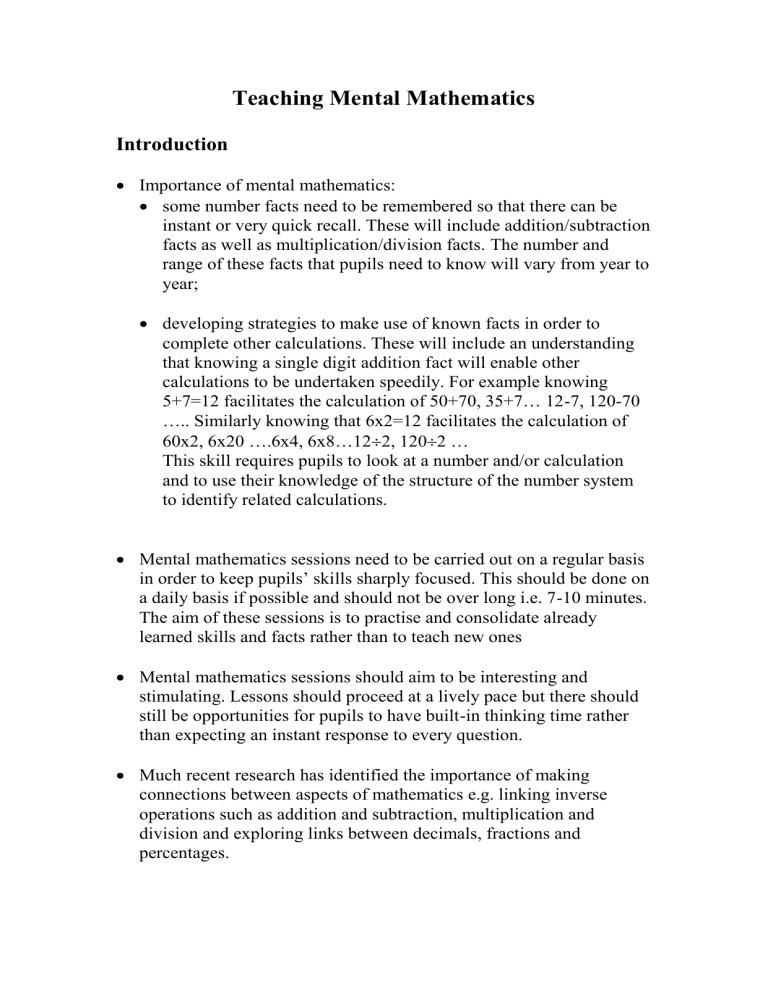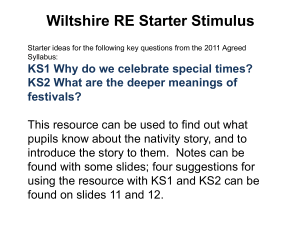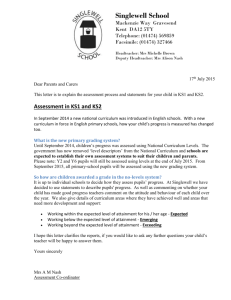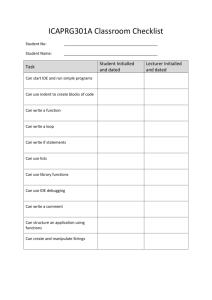mental maths starters

Teaching Mental Mathematics
Introduction
Importance of mental mathematics:
some number facts need to be remembered so that there can be instant or very quick recall. These will include addition/subtraction facts as well as multiplication/division facts. The number and range of these facts that pupils need to know will vary from year to year;
developing strategies to make use of known facts in order to complete other calculations. These will include an understanding that knowing a single digit addition fact will enable other calculations to be undertaken speedily. For example knowing
5+7=12 facilitates the calculation of 50+70, 35+7… 12-7, 120-70
….. Similarly knowing that 6x2=12 facilitates the calculation of
60x2, 6x20 ….6x4, 6x8…12
2, 120
2 …
This skill requires pupils to look at a number and/or calculation and to use their knowledge of the structure of the number system to identify related calculations.
Mental mathematics sessions need to be carried out on a regular basis in order to keep pupils’ skills sharply focused. This should be done on a daily basis if possible and should not be over long i.e. 7-10 minutes.
The aim of these sessions is to practise and consolidate already learned skills and facts rather than to teach new ones
Mental mathematics sessions should aim to be interesting and stimulating. Lessons should proceed at a lively pace but there should still be opportunities for pupils to have built-in thinking time rather than expecting an instant response to every question.
Much recent research has identified the importance of making connections between aspects of mathematics e.g. linking inverse operations such as addition and subtraction, multiplication and division and exploring links between decimals, fractions and percentages.
The use of maths partners can be a useful strategy to provide pupils with increased opportunities to develop their oral skills. After certain questions pupils can be asked to “Talk about how you would do this with your partner” or “Discuss the answer with your partner.” The teacher can then take responses from a variety of maths partners. This enables all pupils to have an opportunity of discussing the calculation/problem with someone else.
Answering devices are designed to reduce the opportunities for children to employ some sort of avoidance strategy. They can be used with individual children but there can also be opportunities provided for them to discuss their answer with another child before responding.
Answers may be shown immediately by individuals or at the command of the teacher – “Show me”. Such answering devices include:
digit cards
number petals or fans
flip overs
flashback boards e.g. mini whiteboards and pen.
Open/closed questions: advantages of open questions:
pupils select appropriate maths
can exceed expectations
differentiation by outcome.
Activities
1. 1-100 digit cards
Distribute to pupils. Ask a range of questions with pupils holding up appropriate cards e.g. a number with a 4 in it, greater than 46, a multiple of 7, an even number, a multiple of 5 less than 37 etc.
Guess my card. Choose one card and say 3 things about it. Can the rest of the children guess it? How many guesses does it take?
Hold up one card. Round to nearest 10.
Children choose one of their numbers and get into order with or without talking.
2. Number washing line
Put on the middle number and build from middle.
Shuffle and build from scratch choosing one card at a time in two teams
(shout lower/higher). Can have a number(s) in middle or end to help.
Daily: count forwards and backwards in ones, in tens from 10, in tens from 14 and other sequences.
N.B. Important to sustain counting throughout KS2, for example count in
25s from 37!
3. Number Puzzles
Think of a number
Double it
Add 10
Half it
Take 5
4. Tell a story
There were 7 passengers on the bus. When it stopped at the bus stop, 4 people got off and 6 people got on. At the next stop, 2 people got off and
3 people got on. How many people are on the bus now?
Children can also invent stories to illustrate calculations: e.g. Tell me the story of 2+4=6 could have the answer There were 2 sheep in the field. Four more came through the gate which meant there were now six sheep in the field.
5. Fizz/Buzz
This involves counting round the class but every time a multiple of say 3 is reached the pupil must say fizz e.g. one, two, fizz, four, five, fizz etc.
This can be further complicated by using two sets of multiples such as 3 and 5 e.g. one, two, fizz, four, buzz, fizz, seven etc. Numbers, which are multiples of 3 and 5, become fizz buzz .
6. Attributes
Say a number or write on board. The next child says another number and explains what they have in common e.g 10…20 (multiples of 10)…6
(even numbers)…9 (less than 10)…36 (square numbers) and so on.
7. Yes or No
Think of a number. Children have to guess the number in smallest number of guesses asking questions with response of yes or no. Good for listening skills.
8. Beat the calculator
Child on a calculator has to solve calculation before children working mentally. This is especially effective if using an OHP calculator.
9. Higher or lower
Use 0-20 digit cards. Turn one over. Will next be higher or lower. Need to think where it comes in sequence and which cards have already gone.
With older children the probability of lower or higher cards can be explored in more detail. This activity can also be used with decimal
/fraction / percentage cards.
10. Lottery
Children write down 6 numbers between 2 and 40. One pupil rolls two 1-
20 dice and calculates total. Children cross out any answers in their list and the dice are passed to the next person.
11.
The answer is ……..
The answer is 6. What is the question?
2+4
6
30
5 3x2
½ of 12
12. Guess my rule
Write a number sequence on board e.g.
1 2 3
Children try to think of 3 numbers, which obey same rule
2 3 4 (consecutive numbers) e.g.
1 2 5
3 5 13 (double second number and add to first) etc.
This is a useful game to reinforce concepts which are a major focus e.g. subtraction, square numbers etc.
13. 24 Game
All schools should have at least 2 copies of the 24 Game, a single-digit edition and a double-digit edition. Ideas for using the game were circulated to schools along with the game. The sleeves which are supplied with the cards are a useful introduction to simple algebra (an unknown number).
14. Target Board/Numbers
These can be home made or are available commercially.
14
40
9
22
12
15
30
3
26
7
26
5
12
24
18
21 40 8 35 2
Which column has the greatest total? How can you tell? Do you need to total them all to be sure?
Which rows will give an even total? How do you know?
How many of the numbers on the board can you make using the digits 3,
5 and 7 and the four operation signs?
……
15 Multiplication Squares (Addition squares)
Draw table on board with missing information. Children have to fill I the missing squares.
16. Mental geometry
Describe a shape a line at a time. Children have to guess the shape. e.g.
It has 4 sides.
It has at least 2 equal sides.
It has 2 pairs of parallel sides.
It has 4 right angles .
Draw a square and a parallelogram of equal length side. Discuss what is the same and different about them.
Imagine a square. Cut it in half. What shapes have you made?
(rectangles or triangles)
Imagine a hexagon. Cut it in half. What new shapes have you made?
(trapezia)
Imagine a cube made of plasticine. Carefully slice of one of its vertices.
What shape is the new face you have made? (triangle)
How many faces / edges / vertices does the old ‘cube’ now have?
17.List Ten
Find 10 or as many as you can
number larger than 5 but less than 20
odd numbers less than 25
odd numbers less than 50 but more than 30
multiples of 4
numbers and their doubles
square numbers
pairs of numbers with a difference of 5
amounts that can be made exactly using just 2p and 5p coins
odd numbers that are multiples of 3 and so on.
Good activity for doing with number partners.
18. Making Numbers
What numbers can we make with 4, 3 and 5 and four operations (or just + and -)
19. Complements to 10 e.g. show me a number you would add to 6 to make 10 Y1
to 20 e.g. 12 to make 20 to 100 in tens 70 to make 100 to 100 in fives to 1000 in 100s to 100 in all pairs
Y2
Y2
55 to make 100 Y3
700 to make 1000 Y3
48 to make 100 Y4 to 1000 in 50s
20. “Three-Way cards”
850 to make 1000
Cards to support 100 square e.g. a number less than 25, a multiple of 3
Y4 etc. These can be used formally during a mental maths session or by individuals/groups in a more informal way.
21. Counting
Count round: girls +3 boys -2: girls -11 boys +9 etc.
Counting with instruction cards e.g. Add 7, Subtract 9…..
Counting with stick:
Early Years Key Stage 1 Key Stage 2
Ordering x2 x8
Use for: decimals/percentages/fractions introducing graphical scales estimating number bonds etc.
22. Collect Odds and Evens
Two teams. Roll 2 dice and use numbers and any of operation signs to make either odd or even totals. Score a point for each one. Rules can be adjusted to suit age group.
23. Syd’s Game (number loops)
Games can be prepared by the teacher (or pupils for other groups of pupils), purchased or downloaded from a variety of Internet sites e.g. www.primaryresources.co.uk
, Leicester LEA
24. 5x5 grid
Find the treasure to practise co-ordinates on a simple 5x5 grid.
25. Countdown
Make a range of totals from given numbers. Can be used for both KS1 and 2. Can also be used for money problems. e.g.
50 200 325 75 125 2
Make 500
325-125=200
50x2=100
200+100+200=500
26. HTU Game
Split into 2 teams. One team rolls a dice and has to decide which column to put the number to make highest/lowest final number. For older pupils use units, tenths and hundredths etc.
27. Snake
KS1: +2, +10
KS2: +19, -11, +1/2 etc.
28. Today’s Date
2/7/00
Add up the digital date: 9
Two numbers that add up to it: 6+3
Two numbers that have a difference of it: 21-3
Double it
Halve it
The next odd number
The 3 rd even number before it
Ten times it; divide it by 10
Multiply/divide by 100
When will the next date equal this number?
What are its factors?
What is half/quarter etc.
What is the nearest square number?
What is the difference between that and the date number? and so on…
The range and difficulty of the questions can be varied to suit the age and ability of the children.
29. Hangman
KS1: number bonds to 10/20
KS2: 4 operations and cheat game
The cheat game ensures that the teacher always wins by having one more digit available than lines needed to complete the hangman logo. Why does the teacher always win?
30. Walking the hundred square
If I stand on 17 and go down 2 squares, then 3 squares to the right and
South 1 square, what number am I on now?
Appropriate language can be used according to age/abilities of children and particular aspects to be reinforced.
31. 25 squared trick
5 squared is 25
What is 15 squared?
It will always end in 25.
So to find 15x15, change the second ten to a twenty and multiply the
1(ten) by the 2(20) which makes 2. This 2 is followed by 25 and hence the answer is 225.
Similarly, 65x65 is 6x7 which equals 42 followed by 25 i.e. 4225.
32. Three little pigs story
There are several Internet sites that have well known stories with associated mathematical questions e.g. www.mathstories.com
33. What if…?
you added every number? How far could you go?
you added odd numbers?
you counted to 100 in tens? What numbers would you say? etc.
34. The ladder game
A pack of 0 to 20 cards are shuffled and one card turned
over at a time. The children decide which rung to put the
number on, the aim being to get ten numbers in ascending
order. Any numbers that will not fit go in the bin. The idea
of the game is to have as few numbers in the bin as
possible. For example, if a 2 is on the bottom rung and a 4
on the one above, if a 3 is turned over it has no proper
and hence must go in the bin. This game can also be
played with fractions/decimals/percentages or with larger
or smaller numbers and different numbers of rungs.
35. The dustbin game
Dustbin
This game is effective when played in pairs or small groups. Each pair has a 1 to 6 dice. The aim is to shake the dice and to put the resulting numbers in the grid so that each column will total 10. This is easy to start with but as the game progresses it becomes more difficult and involves a variety of strategies e.g. is it best to try and get pairs of numbers with different totals so that there is more chance of being able to use any number which appears on the dice. Any numbers which cannot be placed on the grid must go in the bin. When a team has completed all the columns the game stops. The winning team is the one with the highest total of all the columns minus the total of numbers bin the bin. In other words, the first team to finish does not necessarily win.

![afl_mat[1]](http://s2.studylib.net/store/data/005387843_1-8371eaaba182de7da429cb4369cd28fc-300x300.png)






